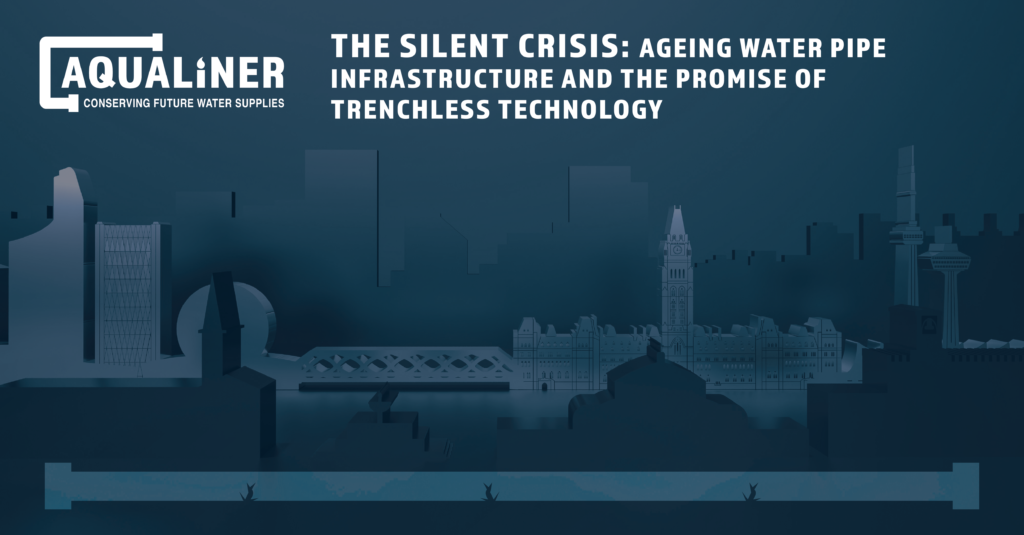The Silent Crisis: Ageing Water Pipe Infrastructure and the Promise of Trenchless Technology

In cities worldwide, the water pipe distribution system is the lifeline that ensures households, businesses, and industries receive a steady and reliable water supply. However, beneath our streets lies an ageing infrastructure quietly reaching the end of its life expectancy. This silent crisis poses significant challenges, including water main breaks, leakage, and contamination risks. 20% of drinking water is lost due to leaks in water pipes. Yet, hope is not lost. Innovative solutions, such as the trenchless technology pioneered by Aqualiner, offer a way forward.
The Problem: Ageing Water Pipes
Water distribution systems in many urban areas were installed decades, if not centuries ago. These pipes, made from materials like cast iron, ductile iron, and even lead, were designed to last around 50-100 years. However, as time passes, many of these systems are overdue for replacement or significant repairs. The signs of ageing infrastructure are becoming increasingly evident:
- Frequent Water Main Breaks: Sudden bursts can cause flooding, property damage, and significant disruptions to daily life.
- Leaks and Water Loss: Aging pipes often develop tiny leaks that can lead to substantial water loss over time, reducing efficiency and increasing costs.
- Contamination Risks: Corroded pipes can introduce contaminants into the water supply, posing health risks to consumers.
- High Maintenance Costs: Repairing old pipes is costly and often involves disruptive excavation.
Addressing these issues is urgent, but traditional pipe replacement methods are expensive, time-consuming, and disruptive to communities.
The Solution: Trenchless Technology by Aqualiner
Enter trenchless technology—a modern method of pipe rehabilitation that minimises disruption and offers a cost-effective solution to ageing water infrastructure. Aqualiner, a leader in this field, provides innovative solutions that renew pipes from within, eliminating the need for extensive digging.
How Trenchless Technology Works:
- The process involves inserting an “engineered liner”, which is an intricate blend of glass fibre and polypropylene filaments, into the pipe to be lined.
- A heating pig is then passed through the woven engineered liner, which heats the material, using hot air, to above the melt temperature of the polypropylene material (i.e. above 180°C)
- The molten mixture of glass fibres and polypropylene is then consolidated against the pipe wall by a pressurised silicone rubber inversion hose.
- Upon contact with the pipe wall, the materials cool down to form a thin-walled structural glass fibre-reinforced polypropylene liner.
Benefits of Trenchless Technology:
- Minimal Disruption: Unlike traditional methods that require large trenches and extensive excavation, trenchless technology involves only small access points, significantly reducing disruption to traffic and daily life.
- Cost-Effective: Trenchless technology often proves more cost-effective by eliminating the need for extensive digging and associated restoration work.
- Time-Efficient: The entire process can be completed much faster than traditional pipe replacement methods, reducing downtime and inconvenience.
- Environmental Impact: This method is less invasive and has a smaller environmental footprint, preserving green spaces and reducing waste.
The Future of Water Distribution Systems
“As our cities grow and our infrastructure ages, the need for innovative solutions becomes increasingly critical. Trenchless technology by Aqualiner exemplifies how we can address these challenges head-on, renewing our water distribution systems with minimal disruption and maximum efficiency. This approach is crucial for building resilient and sustainable urban environments.” – Lord Darren Mott.
For more information on how Aqualiner transforms water pipe rehabilitation, visit our home page.
